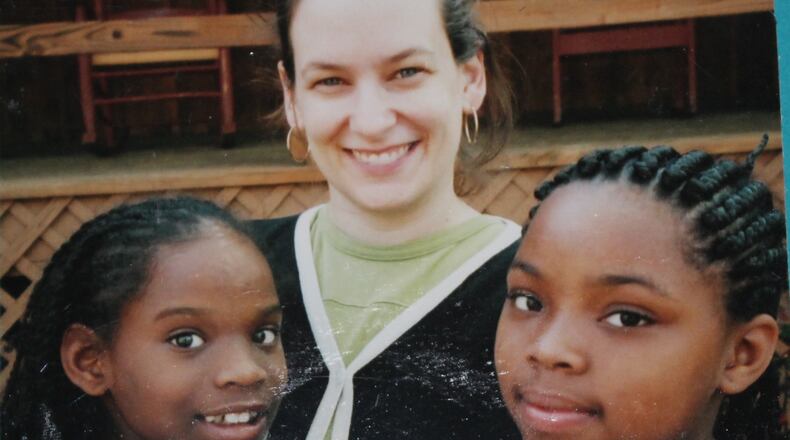Patti Ghezzi, a former education journalist, now works in university communications. (Ghezzi covered education for the AJC from 1997 to 2006.)
Ghezzi volunteered for many years at Atlanta's Whitefoord Elementary School, which closed its doors today, part of the Atlanta Public Schools consolidation plan. In this piece, she talks about the school she knew and loved and the inspiring principal who led it.
By Patti Ghezzi
Whitefoord Elementary, a neighborhood school in Atlanta’s Edgewood community, closed Thursday, shut down because of declining enrollment brought on by gentrification and charter schools.
It was 93 years old.
When former teachers gathered recently to share memories of the school, many recalled Dr. Betty Blasingame, the former principal whose education philosophy defined the concept of a neighborhood school. “Sad to see such an excellent school close,” Roselyn Lewis, the school’s longtime music teacher, who used opera and drumming to engage her students, wrote on Facebook. “You left an excellent legacy, Dr. Betty Blasingame.”
From 1993 to 2002, I was a volunteer at Whitefoords’s Discovery Program, a tutoring program that met every other Saturday morning. Dr. Blasingame was at the helm when I got there and led Whitefoord with fierce love and absolute authority until her death in 1999 of liver cancer.
Back then, there were no buses at Whitefoord. Every student lived within walking distance. On Saturday mornings, the school bustled with energy and volunteers. In addition to the Discovery Program, which was sponsored by Hands on Atlanta, there were scout troops and a camera club. The school had a successful partnership with the Marriott. In 1994, a full-service health clinic opened inside the school.
Dr. Blasingame’s leadership style was her-way-or-the-highway, but she gave teachers latitude to be creative in educating students, many of whom lived in abject poverty.
She made it clear to volunteers that we were not allowed to feel sorry for the students, buy them gifts, or let them down in our commitment to show up every other week. She reminded us often that she was reluctant to allow us into her school, for fear we would lose interest or fail to meet her high standards.
But Dr. Blasingame opened her doors because she knew her students lacked exposure, which she believed was the biggest barrier they faced in escaping poverty. Their worlds were limited to Edgewood, boxed in by Memorial Drive, DeKalb Avenue, Hosea L. Williams Drive and I-20. We brought our exposure to the outside world with us, and we took the kids on field trips to Zoo Atlanta and Fernbank Museum.
She appointed two outstanding teachers to supervise us, and most Saturdays she was there as well, always professionally dressed. She had that steely look that allowed her to discipline without words, but she also loved to talk and talk and talk.
Dr. Blasingame instilled in me everything I believe about public education. Children have needs, and if those needs aren’t met at home, the school must step in. It’s a fool’s errand to teach in a vacuum, blind to children’s hunger, neglect, isolation, and other obstacles.
Her love for Whitefoord was intense, as was her disappointment when students fell short of her expectations. One morning a recent graduate came to the school to show off her newborn. Dr. Blasingame stopped the girl at the front steps. She did not allow former students to give the impression teen pregnancy was cool. “Don’t bring that baby here,” she said. “Turn right around and go home.”
Less than a month into my stint co-leading first grade, she came into the classroom and chewed me out for not preparing enough activities. “It’s chaos in here, and you have as many adults as you have kids,” she said. “Patti, these children need something to do.”
From then on, I prepared enough art projects, science activities and worksheet packets to keep kids busy for days.
I was rewarded for doing things Dr. Blasingame’s way. I got invited to a volunteer appreciation event, and I was the commencement speaker at kindergarten graduation. She sent a letter detailing my attributes, cc’ed to Hands on Atlanta.
Volunteers marveled at the artwork and writing displayed on the walls, especially poetry that detailed the students’ experiences growing up poor. One year, Dr. Blasingame’s theme was “Peace Begins with Me,” and students wrote about the violence in their lives. Volunteers shed tears over essays titled, “When I Become a Parent” and “If I Won the Lottery.”
Whitefoord’s test scores were higher than expected for a school serving low-income children, especially in the lower grades, when teachers could capture their students’ love of learning before they fell under the influence of peers who regarded education as uncool.
At Dr. Blasingame’s packed funeral, the Atlanta school board chairman summed up her legacy: “Whitefoord is a school that works.”
After her death, the accountability movement swept in full force. I watched the new principal and teachers adapt to ever-changing demands and the increasing weight of standardized test scores, a direction Dr. Blasingame would have decried as misguided. As the accountability movement squeezed Dr. Blasingame’s holistic philosophy, changes in Edgewood impacted Whitefoord.
Several of the falling-down homes my students lived in were renovated and sold, and loft condos sprang up next to the boarded-up apartment building where my favorite students, Alan and Marcus, once lived. Charter schools diverted children away from Whitefoord.
Dr. Blasingame believed schools were inextricably bound to their communities, feeding off each other’s success and failure. But Edgewood changed until it could no longer support a neighborhood school, an all too familiar scenario in urban neighborhoods. I am filled with despair when I see the negative impact of gentrification and school choice, having participated in both. I once owned a house in gentrified East Lake, and my daughter attends a charter school.
I’m sadder still to witness the public education pendulum having swung so far away from Dr. Blasingame’s belief that kids need more from their schools than math and reading instruction. She gave students a broad education that included field trips, music, art and extracurricular activities, essentials now found in charter schools and in neighborhood schools in affluent areas but not in low-income neighborhood schools.
Every child deserves such an education, as well as a principal who gives them the opportunity to be part of their community without being limited by it.
About the Author
Keep Reading
The Latest
Featured




